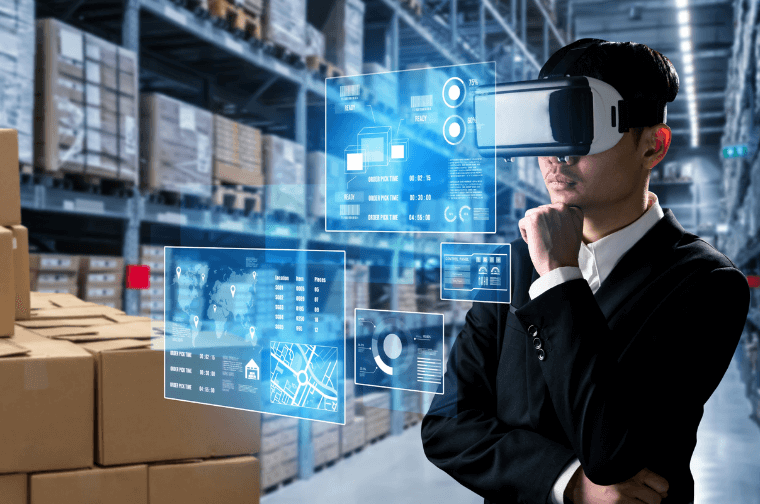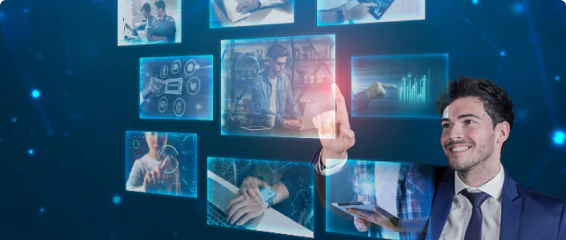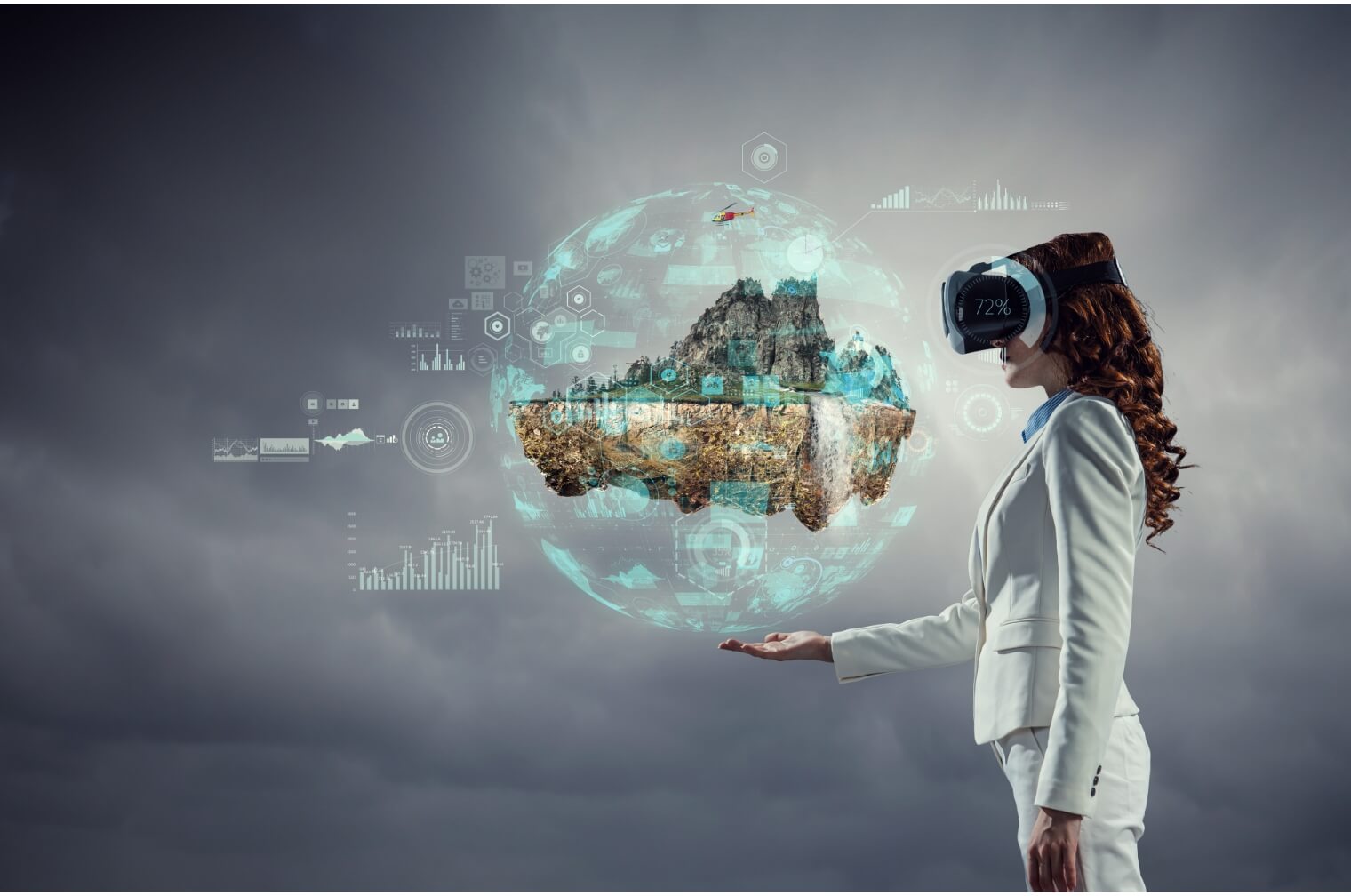Machine Learning and AI for revolution of Tech Companies are changing and streamlining businesses.
The eCommerce industry is growing exponentially, presenting challenges and opportunities for the logistics industry. In the digital world where speed and convenience are the two most important things, logistic companies constantly seek more efficient and innovative solutions to streamline their operations and enhance customer experiences. Here is when VR and AR eCommerce Logistics development comes into the picture.
Rise of virtual and augmented reality in e-commerce logistics
Virtual reality (VR) technology generates a computer-simulated environment, immersing users in a virtual realm usually via headsets or goggles. By substituting the physical world with a digital environment, VR endeavors to deliver a complete immersion digital experience service.
Augmented Reality (AR), on the other hand, overlays digital information onto the real-world environment. It enhances the physical world by adding a layer of virtual objects, images, or information onto the user’s view of the actual world. Simply put, AR does not replace the real world, as VR does, but it adds digital elements, offering a mix of the physical and virtual worlds.
Applications of Virtual Reality (VR) and Augmented Reality (AR) are no longer limited to the gaming and entertainment sector. These breakthrough technologies are making waves in almost every sector, and eCommerce logistics is no exception.
Both AR and VR have gained significant popularity in recent years. They can potentially address some of the key challenges witnessed in the eCommerce logistics sector. In this blog post, you will explore how AR and VR technology is benefiting the eCommerce logistics industry in a number of ways. Continue reading!
Applications of AR solutions for eCommerce logistics
AR technology is increasingly being adopted in eCommerce logistics for various benefits. Let’s explore what these 3d eCommerce development are.
Efficient order picking and packing
AR solutions can help optimize the process of order picking and packing in warehouses. AR-enabled smart glasses or mobile devices can overlay digital information onto the workers’ field of view and guide them on which items must be picked, in what quantity, and from which location.
So, basically, AR technology helps reduce picking time, enable fast shipment, and enhance the overall accuracy of the process. It can also be used to identify misplaced items in the warehouse, which ultimately helps in efficient inventory management.
Real-time inventory visualization and tracking
Warehouse managers can leverage AR interfaces to get real-time insights into inventory location, movement patterns and levels. AR can help you overlay digital labels onto all physical items, enabling you to track all product information easily and accurately.
Leveraging augmented reality in logistics will help you monitor stock movement and identify low stock levels more effectively. If there is any discrepancy in inventory management, the AR solution will help you spot it more quickly.
Improving last-mile delivery
Last-mile delivery us a significant part of eCommerce logistics, and AR assistance can help improve it in a number of ways, including:
Route optimization: Augment reality logistics can help delivery drivers find the most efficient routes to their destinations, considering factors such as traffic conditions, weather, and delivery windows. This can help save a good amount of time and fuel.
Navigation: AR navigation solutions provide turn-by-turn directions and highlight potential hazards or obstacles on the road. This helps drivers make informed decisions and choose the best routes to optimize delivery time and minimize fuel consumption. This helps reduce the chances of missed or failed deliveries.
Proof of delivery: AR devices can be used to capture digital signatures and photos of deliveries, proving that the package was delivered to the correct person at the correct time. This provides an indisputable record of successful delivery and assists in resolving any delivery-related disputes.
Customer communication: The AR interface can be used to communicate with customers about the delivery status, tracking information, and estimated delivery time of products. This can help to improve customer satisfaction and reduce the number of customer service inquiries.
AR eCommerce Logistics development is playing a vital role in streamlining supply chain management processes in this industry. By providing real-time information and enhancing navigation capabilities, AR solutions optimize route planning, navigation, and last-mile delivery.
Virtual try-on and product visualization
Investing in AR application development enables customers to try on products virtually and visualize them in real life. By using AR applications on their mobile devices, customers can overlay virtual images of products onto themselves and visualize how they would look or fit.
This virtual try-on feature is more valuable for industries such as fashion, eyewear, and cosmetics, where customers can visualize how clothing items, eyeglasses, or makeup products would appear on them before making a purchase. This feature reduces the need for physical try-ons, increases customer confidence, and reduces the possibility of product returns.
AR-enabled product information and reviews
This AR-enabled product information and reviews enhance the overall customer experience, reduce information asymmetry, and increase customer satisfaction. Customers can access detailed product specifications, user reviews, and ratings by scanning product labels or codes using AR applications.
AR overlays this information onto the physical product or displays it through the AR interface, allowing customers to make more informed purchasing decisions. They can learn about product features, compare different options, and read reviews without the need to search for information on separate websites or platforms.
VR advancements in AR eCommerce logistics development
There are several ways VR technology is reshaping the realm of ecommerce logistics. Let’s understand it in detail.
VR-based training and simulation for warehouse operations
One of the key applications of VR in e-commerce logistics is providing warehouse workers with immersive training and simulation experiences. With VR-based training, warehouse employees can practice order picking, packing, and inventory management tasks within a safe and controlled setting of the virtual world. Such training sessions help improve their skills, reduce errors, and enhance overall productivity.
Additionally, VR-driven simulations enable employees to familiarize themselves with complex machinery and equipment. They can learn how to operate forklifts, automated picking systems, and other warehouse technologies without the risk of accidents or damage to inventory.
Virtual layout planning and optimization
This is another application of VR in warehousing and fulfillment centers. Designing an efficient and ergonomic warehouse layout can involve factors such as product placement, picking routes, and storage capacity.
Using VR for eCommerce logistics enables businesses to visualize and simulate different layout configurations before implementing them physically. Warehouse managers can create virtual representations of their facilities and test various layouts to identify the most optimal arrangement.
VR solutions for supply chain visualization and analysis
In addition to its applications in warehousing, Virtual reality logistics is also harnessed to enhance supply chain visualization and analysis. Ecommerce businesses can leverage immersive VR environments to represent various supply chain metrics, such as inventory levels, transportation routes, and demand patterns.
VR for supply chain management facilitates a deeper understanding of the data, enabling decision-makers to identify trends, bottlenecks, and opportunities in the supply chain network.
By visualizing data more intuitively and interactively, organizations can make data-driven decisions more effectively, improving operational efficiency and responsiveness.
VR-based predictive analytics for demand forecasting
One of the biggest challenges for eCommerce businesses is accurately forecasting demand. This helps in inventory management as well as in supply chain optimization. VR-based predictive analytics leverages advanced AI algorithms and machine learning techniques to analyze historical data, market trends, and other relevant factors to forecast future demand patterns of the stocks.
VR for eCommerce logistics enables decision-makers to interact with demand forecasts more intuitive and immersive. They can explore different scenarios, simulate the impact of various factors on demand, and make informed decisions based on the insights provided by VR solutions.
Virtual showrooms and immersive shopping experiences
Virtual showrooms enable customers to explore and interact with products in a virtual environment, providing a more engaging and realistic shopping experience. Customers can visualize products in 3D, examine them from different angles, and even try them virtually before purchasing. VR-powered virtual showrooms help bridge the gap between online and offline shopping experiences, enhancing customer satisfaction and reducing the likelihood of returns.
Moreover, virtual showrooms can be customized based on individual customer preferences. By collecting and analyzing customer data, businesses can create virtual environments that showcase relevant products, recommend complementary items, and tailor the shopping experience to each customer’s preferences and needs.
Intelligent virtual assistants and chatbots
VR-driven virtual assistants and chatbots offer a new level of customer support and engagement. By integrating VR technology into chatbot interfaces, businesses can create virtual assistants capable of guiding customers through their shopping journey, answering queries, and providing personalized recommendations.
These virtual assistants can offer more interactive and immersive interactions with customers. They can showcase product features, provide demonstrations, and even simulate how products look and function in real-world settings. This enhances customer engagement and improves overall customer satisfaction.
Real-world examples: AR and VR-powered e-commerce logistics
In recent years, many companies have successfully implemented AR and VR solutions to revolutionize various aspects of their supply chain operations and enhance the overall customer experience. Let’s explore some real-world examples of how AR and VR are powering e-commerce logistics:
- Amazon: One of the world’s largest e-commerce giants, Amazon, has implemented AR in its warehouses to improve order-picking efficiency. Workers wear AR glasses that display information about the items they need to pick, helping them locate and pack items more quickly and accurately. The company also uses AR to help its delivery drivers find the correct addresses in dense urban areas. They also use VR to train their warehouse workers to pick and pack orders.
- IKEA: They have embraced both VR and AR solutions for eCommerce logistics. The IKEA Place app allows users to visualize how furniture will look in their homes before purchasing. And their VR experience app allows users to browse product catalogs and explore a virtual home in 3D where they can see how different products will look. These applications enhance the customer experience and reduce the likelihood of returns.
- Walmart: The company’s AR app helps product delivery drivers navigate dense city areas; it provides directions to the specific apartment unit where they need to deliver the package.
- FedEx: They use VR to train their employees for various tasks, including package handling, customer service, and safety. The company’s VR training program helps employees learn new skills and procedures in a safe and immersive environment.
- L’Oreal: This global cosmetics brand has integrated AR into its e-commerce strategy. They offer virtual try-on experiences, allowing customers to test makeup products through their smartphones or computers before purchasing. This not only boosts customer engagement but also reduces the number of returns.
- Lowe’s: The home improvement retailer employs AR in its stores to assist customers in finding products. The Lowe’s Vision app uses AR to guide customers to the location of items on their shopping lists, making the shopping experience more convenient.
- UPS: They use AR to help their delivery drivers capture digital signatures and photos of deliveries. The company’s AR app allows drivers to scan a QR code on the customer’s smartphone to capture their signature and then take a photo of the package at the delivery location.
Future trends and innovations in AR and VR for eCommerce logistics
As augmented reality (AR) and virtual reality (VR) technologies continue to evolve, the potential for their application in eCommerce logistics is expanding. Looking ahead, here are some future trends that we can expect to see in this domain:
- More immersive experiences: As AR and VR hardware and software continue to improve, we can expect to see more immersive and lifelike experiences for eCommerce logistics. This will allow customers to have a more accurate understanding of products and services before they buy them.
- Wider adoption: We can expect to see more eCommerce businesses adopt these technologies. This will lead to a wider range of AR/VR applications in eCommerce logistics, such as virtual showrooms, AR-guided picking and packing, and VR-powered delivery drones.
- More innovative solutions: As these immersive technologies continue to develop, we can expect to see new applications emerge in this space. For example, we may see AR/VR used to create virtual warehouses that can be used to store and manage inventory more efficiently. VR can be used to develop autonomous delivery drones that can navigate and deliver packages without the need for a human driver. This could revolutionize last-mile delivery.
Final thoughts
All the real-world examples and applications of AR and VR in the eCommerce logistics sector make it evident that these immersive technologies are transforming this niche from warehouse management and order fulfillment to customer experience and last-mile delivery.
These eCommerce AR advancements and VR-powered logistics will continue to redefine how the supply chain operates, making them more efficient, cost-effective, and customer-centric. Want to harness the power of VR and AR eCommerce Logistics development? Book a free consultation with our tech experts NOW!
Frequently asked questions
What are the future trends in AR for e-commerce logistics?
Future trends in the niche of AR eCommerce Logistics development include more immersive AR experiences, innovative AR applications, and wider adoption of this groundbreaking technology by eCommerce businesses.
How is AR being used in e-commerce logistics today?
Ecommerce businesses primarily use AR to improve customer experiences, optimize supply chain operations, and train workers.
How to use AR in eCommerce?
To use AR solutions for eCommerce logistics, integrate AR technology into product visualization, allow customers to virtually try products, and implement AR overlays for real-time product information and interactive shopping experiences.









